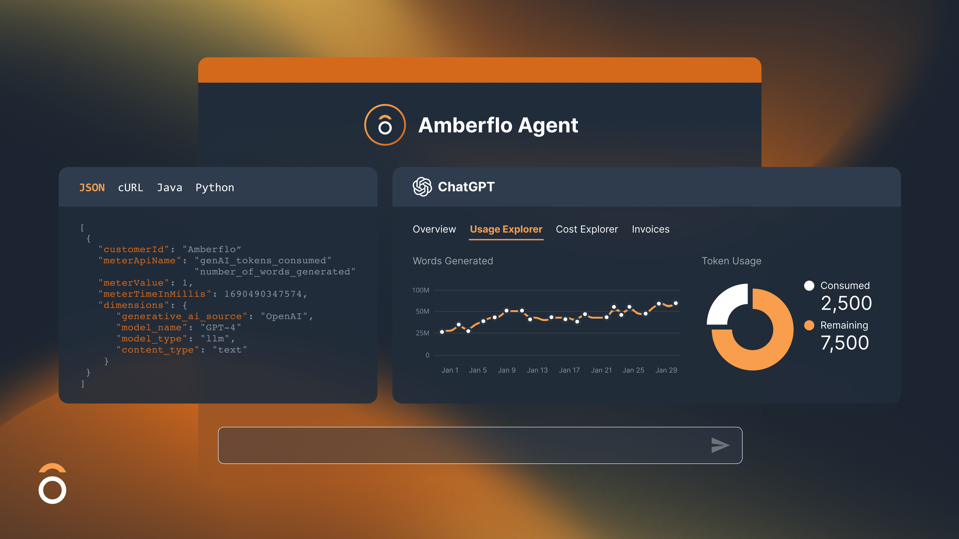In the rapidly evolving business landscape, Artificial Intelligence (AI) is no longer just a buzzword or a futuristic notion; it’s a robust tool that’s reshaping how businesses operate and compete. About 35% of businesses report using AI in some capacity, according to IBM. And recently, most of AI usage is in the form of Generative AI. Software companies are starting to bake tools like ChatGPT into their own applications to add unique value for their customers.
But there’s one problem: How can these companies actually make money from these new applications? “Too many companies are showing up to the goldrush without a shovel,” says Puneet Gupta, CEO and Founder of Amberflo , an AI Monetization platform.
Simply put, most companies are rushing to the AI trend to keep up with their competition, but with no real plan in place for monetization. Most are actually losing money as they pay companies like OpenAI for tokens. The solution to this problem seems to be instrumenting usage-based metering, which can monitor how much companies are spending on AI, as well as how much their own customers are consuming, in order to up-charge fairly and make a profit.
Understanding AI’s Monetization Potential
AI’s core strength lies in its ability to process, analyze, and interpret vast amounts of data faster and more accurately than humans. Now that many companies have grown comfortable using AI to improve their internal processes, they are turning their attention outward to find ways to benefit their customers.
“By emphasizing fairness, transparency, and alignment between service providers and customers, we can ensure mutual benefit. The monetization of AI should be democratized, allowing innovators as well as enterprises to profit,” says Gupta. “Whether for cloud-based app developers, tech companies, or businesses in the information sector, AI’s capability can be leveraged in numerous ways for monetization.”
Customers use an average of nine touch-points to engage with a brand, according to Salesforce. This highlights customer service as a key area of monetization opportunity for companies of all sizes. Because AI enables hyper-personalization in customer interactions, companies can leverage it to offer personalized recommendations, content, and services, significantly increasing customer engagement.
The Three Pillars of Monetizing AI
1. Usage Metering
Usage metering entails the tracking of all service consumption. In order to truly obtain a complete picture of the revenue and costs, each request (prompt and response) should be metered. This allows for tracking both internal costs incurred from providing service for each customer’s usage, and the revenue generated from that same usage.
Without a solid, accurate, and real-time metering foundation tracking each request as it takes place, it is impossible to accurately forecast costs or bill customers fairly.
2. Quoting (CPQ) and Forecasting
Price forecasting involves anticipating usage and generating a quote based on the given usage volume, according to some pricing plan. The anticipated usage should be plugged into the pricing plan to generate a quote. There are a number of strategies a company can take from here – the quote can serve as the basis of pricing negotiations, or a pricing calculator can be made publicly available on the website to allow customers to estimate their own forecasted costs when making buying decisions. Commonly in the SaaS model, quotes are negotiated back and forth and when accepted, parlayed into a long-term contract.
Over time, the customer should be able to view their usage and see how it compares to the anticipated usage. If they are using more than the anticipated amount, they may be able to renegotiate the contract to obtain a greater discount for greater committed usage. Conversely, if usage is lagging behind the anticipated volume, they can take action to increase adoption or perhaps look to update the quote terms based on the actual usage volume. This ensures there are no surprises when the bill comes due.
3. Modern Billing
The final piece in the puzzle with usage metering and price forecasting is a modern billing solution that can accurately invoice and charge each customer based on their usage of the generative AI service. Users should be able to create flexible pricing plans, combining usage-based, seat-based, and fixed-rate elements together as needed. The billing service must leverage the metering service which tracks usage to then apply the rating (pricing) logic in real time to generate metered invoices. Customers and users alike must be able to see the up-to-date invoice balance at any point in a billing cycle to guarantee maximal fairness and total transparency in billing.
AI Is A Transformative Technology, Not A Fad
Unlike previous false starts and so-called “AI winters” it seems apparent that this time generative AI is not a mere fad but a transformative technology that will soon become standard fare in the next generation of solutions. Companies that lag behind in gaining familiarity with this new paradigm can be disrupted by smaller, newer outfits that are successful in leveraging generative AI to make legacy solutions (or even whole categories) more efficient, personalized, and capable.
While there may be some early rewards for companies that are quick to deliver the first solutions in this category, the lasting winners will be those that are successful in defining and implementing long-term strategies for growth and monetization. If you are a software company baking GenAI into your applications, you may very well want to ensure you are showing up to the goldrush with a shovel.

